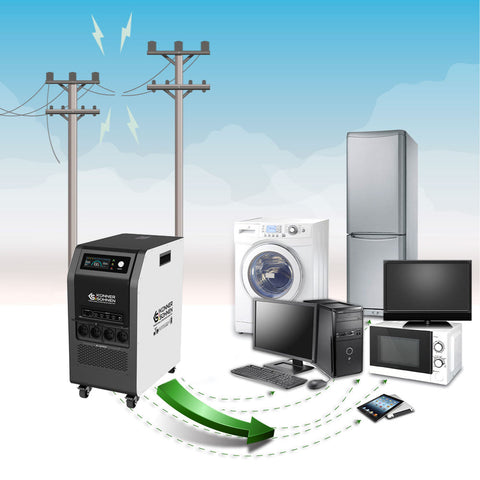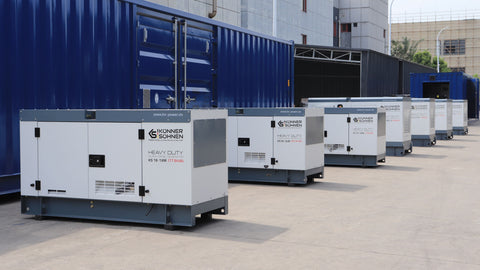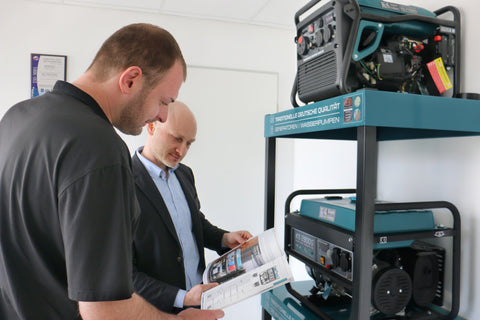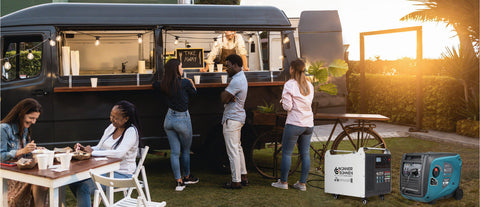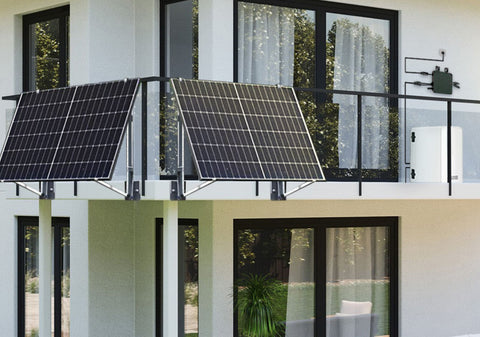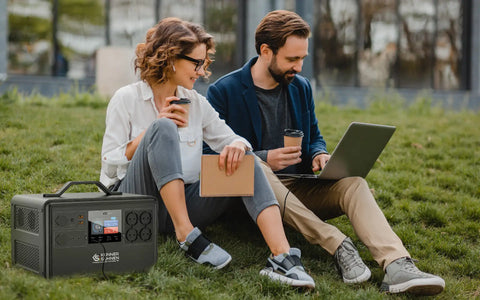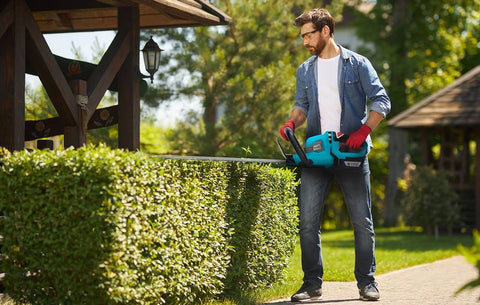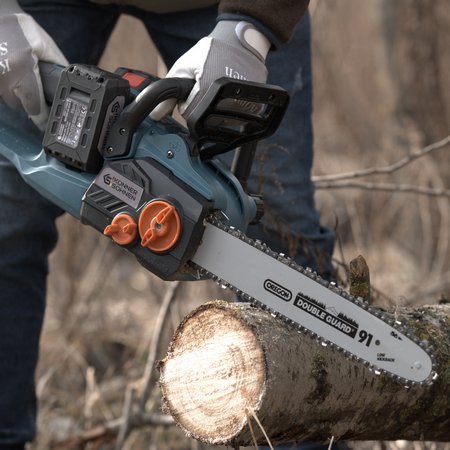Our generators are designed as IT systems and feature basic protection through basic insulation of the live components. This is a protective separation. The PE pins in the sockets, as well as the grounding screw, are connected to the body of the generator. The generator housing is insulated from the live L and N lines.
Emergency power supplies in buildings must usually be installed as a TN system. In this case, the generator and its neutral conductor must be grounded. The generator's grounding screw must be connected to the building's main earthing bar using a 6-10 mm² copper cable. If this is missing, a grounding connection must be built for the generator. The PE conductor from the generator socket goes to the grounding screw in the distribution box, which in turn must be connected to the main earthing bar. The N conductor from the generator socket must be grounded at the connection point in the distribution box. This can be done by placing a bridge between N and PE on the generator side of the transfer switch.
Inverter generators from Könner & Söhnen deliver 230V and, provided the rated and maximum power are maintained, can be used for 230V household feed-in. This allows them to supply almost all household electricity consumers.
Do my electrical appliances need 230V or 400V?
400V three-phase current is generally only needed by devices that require a rotating field. These are power consumers with three-phase motors, such as tools, pumps, etc.
Such power consumers as the electric stove, powerful instantaneous water heater, fan heater, electric boiler or sauna are connected to 3-phase only for the purpose of load distribution in the VDN network and are in fact 230V power consumers that can be supplied by a 230V generator.
230V power consumers with a total power of more than 4.6 kVA must be connected to 3 phases for load distribution when operating from the external power grid. In emergency power operation, when using a non-unbalanced load emergency power generator, they must be supplied with 230V, but must not be brought to full power to avoid overloading the neutral conductor.
Power consumers such as electric stoves are typically connected with a 5 x 2.5 mm² copper cable. Thus, when powered by the generator, a pair of cooktops, or a cooktop and an electric oven, can be operated without any problems without overloading the neutral conductor of the supply cable. Provided the generator itself has sufficient power. The same applies to instantaneous water heaters, fan heaters, electric boilers, saunas, etc., which have internal 230V heating elements and are, in fact, 230V power consumers.
In conventional generators (also with AVR), the current is taken from the winding of the alternator and the shape of the voltage can be different depending on the design of the generator.
The voltage frequency of a conventional synchronous generator is determined by the motor speed, which can fluctuate depending on the load. The AVR controls the effective voltage, but not the voltage waveform, and for sensitive power consumers, the voltage waveform is particularly important.
In inverter generators, the voltage is generated electronically and has a much more stable shape and parameters and these are recommended for sensitive power consumers such as electronic devices, LED lighting, etc.
Comparison of voltage (yellow) and current (green) of an inverter and a conventional generator under electronic load (electronic device with switching power supply):

Inverter generator

Conventional generator
Conventional generators (even with AVR) experience significant distortion under non-linear loads.
You can find out whether the respective electronic device can be supplied with a conventional generator or whether it absolutely requires an inverter voltage from the manufacturer of the device, because only the manufacturer knows exactly how his device is constructed and how it reacts to distortions in the voltage waveform.
Here is the recommended connection plan for a house feed-in according to the VDN guideline for the planning, construction and operation of systems with emergency power generators:

Emergency power supply with an inverter generator for a 1-phase house connection:

The neutral and ground conductors from the generator must be bridged at the transfer switch. This creates a TN system with the grounded neutral conductor on the generator side.
An emergency power generator with inverter technology is significantly lighter and smaller than conventional generators with the same power and can be used both for home supply and mobile use.
We recommend installing a load transfer switch in the house distribution board and a feed-in box on the house wall to which a generator can be connected if necessary.

The generator grounding screw must be connected either to the building ground via the pre-installed fixed ground terminal or to a specially constructed grounding system. The neutral conductor is grounded by a bridge between neutral and PE (TN system).
Operating the generator with bridged neutral and PE conductors without grounding is prohibited for personal safety reasons. If this is missing (e.g., with a TT external grid connection), a separate grounding connection must be installed and the generator grounding screw connected to it. The PE pin in the socket is connected to the grounding screw, and the connected load is also grounded through this pin.
The Schuko plug can be reversed on the generator, as the two current-conducting contacts in the Schuko socket are equivalent as long as neither is grounded. The determination of L and N and the connection between N and PE (grounding of the N conductor) only takes place on the house side behind the CEE feed-in socket.
The second, free Schuko socket (models with two Schuko sockets) receives the grounded neutral conductor immediately after connecting the power cable from the first socket to the feed-in socket, as the two Schuko sockets on the generator are connected in parallel. The Schuko socket is designed for currents of up to 16A, allowing the full power (generators up to 3600W) to be drawn from a single socket.
The generator can be connected to the power outlet using a standard CEE adapter cable (Schuko to CEE). No permanent installation is required; the generator is only used in the event of a power outage and can be connected at any time without major effort.
The CEE 230V 16A feed-in box is sufficient as a feed-in box for generators with a power output of up to 3600W. However, we recommend using a 4-6 mm² (copper) cable between the changeover switch and the feed-in box so that the feed-in box can be easily replaced with a more powerful CEE 230V 32A if necessary.
Two identical inverter generators with parallel connection can be connected using the KS PU1 parallel connection box. This doubles the total power and the connection is made via the CEE 230V 32A socket.

The connection cable should be a standard copper cable CEE 230V 32 A coupling to CEE 230V 32A plug with 4-6 mm² per wire.
With this scheme, uninterrupted operation can also be achieved if the two generators are switched off alternately to cool down.
Both generators are connected to a parallel switch box and only then can they be started one after the other. The second generator to start synchronizes with the first.
The KS PU1 parallel switching box also has overload protection (LS switch) for each socket.
The banana plugs for connecting to the generator are protected against direct contact with the conductive contacts, but must be protected from moisture so that it does not penetrate the plug and cause an electric shock when touching the plug.
Inverter generators from Könner & Söhnen are equipped with electronic overload protection. If this is triggered, you must disconnect the excess load and press the "AC Reset" button to restore power.
A residual current device (RCD) should generally only be used after disconnecting the neutral and protective earth (PE). The residual current devices already present in the distribution board will function as contact protection for end users. A residual current device (RCD) directly on the generator will not work, as the neutral and protective earth (PE) connections only occur after the load transfer switch.
A copper cable with a cross-section of 6-10 mm² must be used as the earthing cable, depending on the local regulations.
Please note:
A generator must not be used as a replacement for the public grid in a grid-commutated or hybrid inverter. The resulting backfeed can damage the generator.
Disclaimer:
This manual is intended only as a guide, is illustrative, and must be adapted to the specific circumstances and conditions on site during installation. The installation itself must be carried out in compliance with all standards and regulations. We assume no responsibility for incorrect installations and their consequences.

